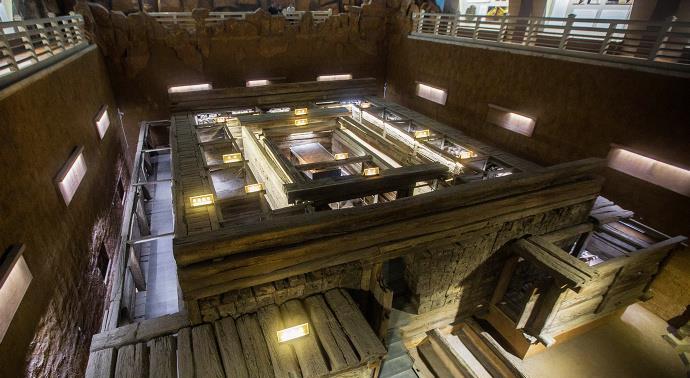In 1979, on Shenju Mountain in Tianshan Town, Gaoyou City, 45 kilometers from Yangzhou City, Jiangsu Province, local farmers discovered two large ancient tombs while mining mountain stones. Later, according to archaeological experts, the two tombs were the tombs of Liu Xu, the son of Emperor Wu of Han, the first Guangling king of the Western Han Dynasty, and his queen. Its scale is 18 times larger than the Mawangdui Han Tomb in Hunan, and the tomb belongs to the highest level of ancient "Yellow Intestine Inscription" type wooden tomb, with a grand scale and rigorous structure, which is a rare large-scale Han Dynasty tomb, with a history of more than 2,000 years. The discovery of the tomb of King Guangling of Han guang was a sensation at home and abroad for a time.

Photographed in Yangzhou, Jiangsu Province.
Due to the stone chiseling of the mountain on The Sacred Residence Mountain, the mountain is loose, which is not conducive to the protection of the tomb. In 1992, the tomb of the Hanguang Tomb was moved to Yangzhou, Jiangsu Province, and the original tomb components were reconstructed according to the original tomb style, and the Hanguang Tomb Museum was built.
With the efforts of many parties, the underground palace in the museum has basically restored the appearance of the original site. In the original tomb, the wooden tomb of Liu Xu, the king of Guangling, was buried 24 meters underground, and after moving to Yangzhou, in order to reproduce the characteristics of deep burial at that time, the entire wooden tomb was also arranged in the underground palace.
Liu Xu was the fourth son of Emperor Wu of Han, Liu Che, and the half-brother of Liu Dan the Prince of Yan. During the Han Dynasty, Yangzhou was an important town in Jiangnan, and Liu Che sent his son to administer Yangzhou. Liu Xu liked to play, behaved without law, and eventually failed to become the heir to the throne. During the reign of Emperor Zhao of Han, Liu Xu coveted the throne and cursed the witch. Later, due to the discovery of the curse, Liu Xu hanged himself and attacked the lord with his son Liu Ba.
After Liu Xu's death, he still used the "Yellow Intestine Inscription" according to the highest imperial treatment of the Han Dynasty. "Inscription" is a burial style, which is a frame structure made of cypress wood (i.e., square wood) stacked around the chamber. It is mostly found in the Zhou Dynasty and Han Dynasty, and is rarely used after the Han Dynasty. "Yellow intestine" is named after the bark stripped of the wood used in the inscription, and the wood color is pale yellow.
Liu Xu's mausoleum, displayed in the Guangling King Tomb Museum, is known as the "No. 1 Han Tomb". There is a circle of viewing passages around the tomb, which can be viewed from above, and the entire "yellow intestine inscription" is displayed in front of you. It is a large tomb with a square, wooden structure, and the burial chamber is divided into several "rooms" of different sizes. It is basically a reproduction of the scene of the tomb owner's life when he was alive.
Although the tomb is well preserved, it has also been stolen. When the tomb was excavated in 1979, the bones of the tomb owner had been dragged out of the coffin by the tomb robbers, and only sporadic fragments of golden jade clothes and some daily necessities were unearthed inside the coffin.
The selection of materials for the "Yellow Intestine Inscription" of the Tomb of King Guangling is quite well-considered, all of which are made of golden silk nan wood as components, with a total of 856 pieces, equivalent to about 545 cubic meters of wood. Each piece of question is different in size and is all connected by mortise and tenon. It is said that when it was excavated, even the thinnest blade at that time could not be inserted into the wooden rafter of the Nan wood structure, which shows how exquisite the production process of more than 2,000 years is.
It is worth mentioning that the entire tomb is made of 856 pieces of gold silk nan wood spliced together. Golden silk Nan wood is a unique precious wood in China, from the Qin Dynasty to the Qing Dynasty are exclusive to the royal family, the Forbidden City in Beijing and the ancient buildings in the capital are mostly built of Nan wood. Nan wood does not rot and does not moth with a faint fragrance, in ancient times there is a saying that "one or two golden silk nan wood is worth one or two gold", which can be seen in its preciousness. Isn't this room full of gold all gold, how much is it worth?
About the author: Cold and cruel leaf (photographer, traveler, self-media person).